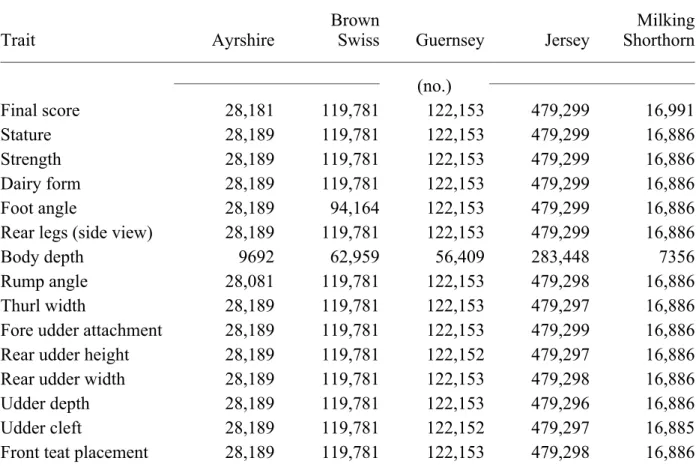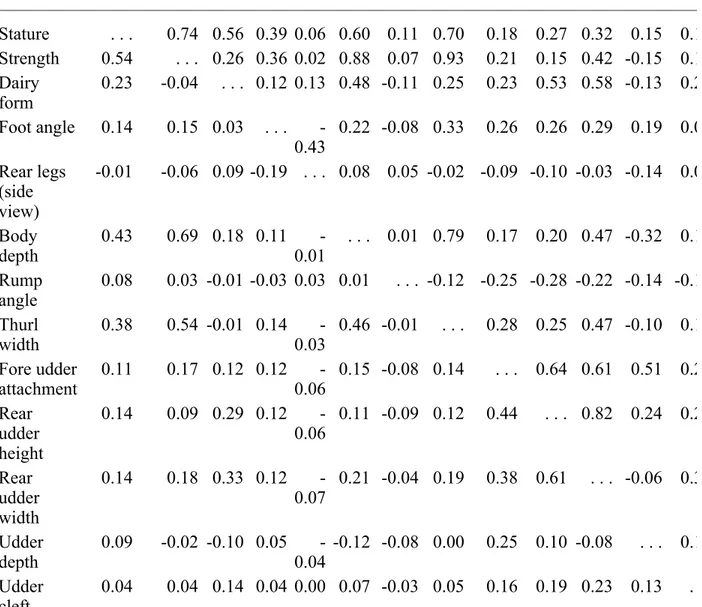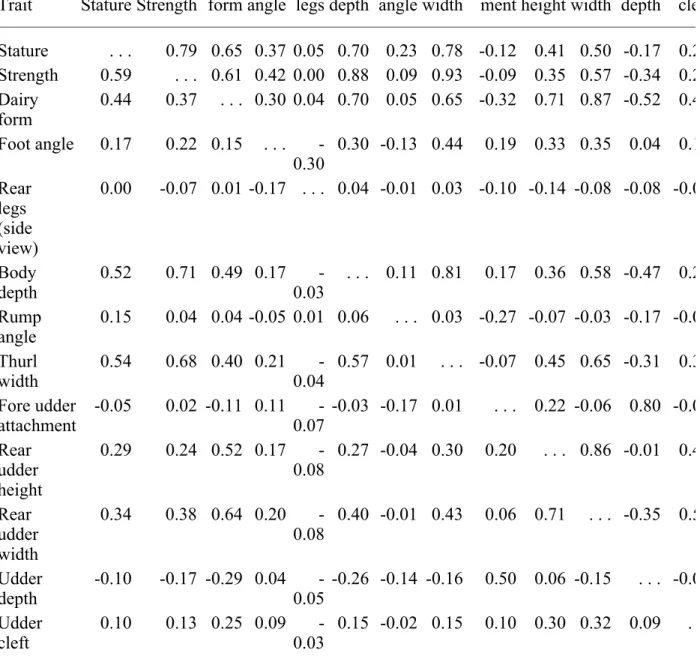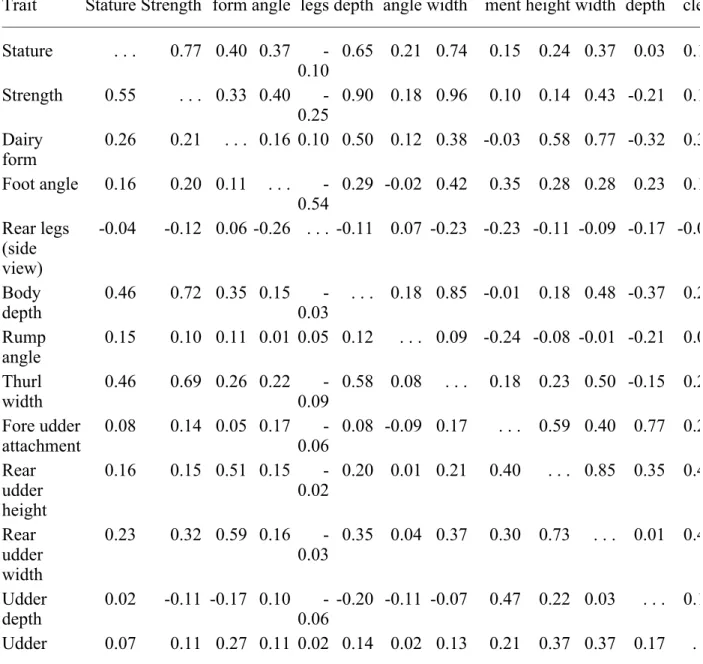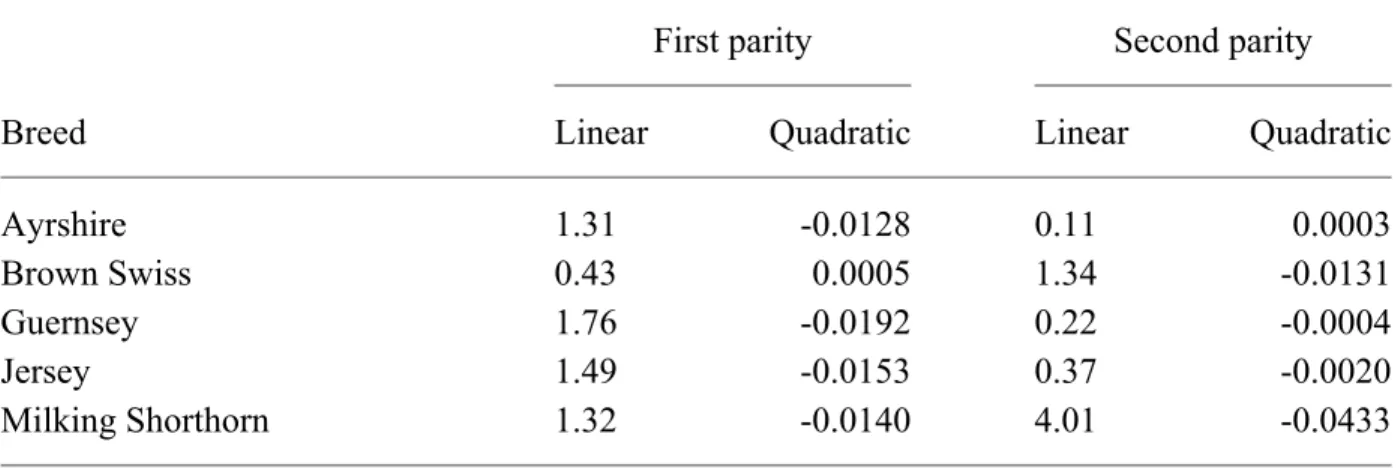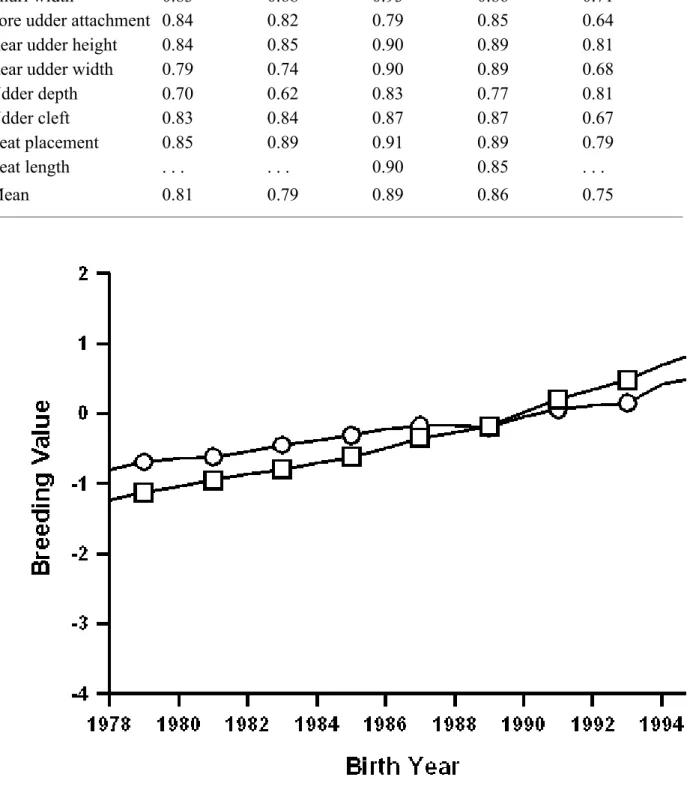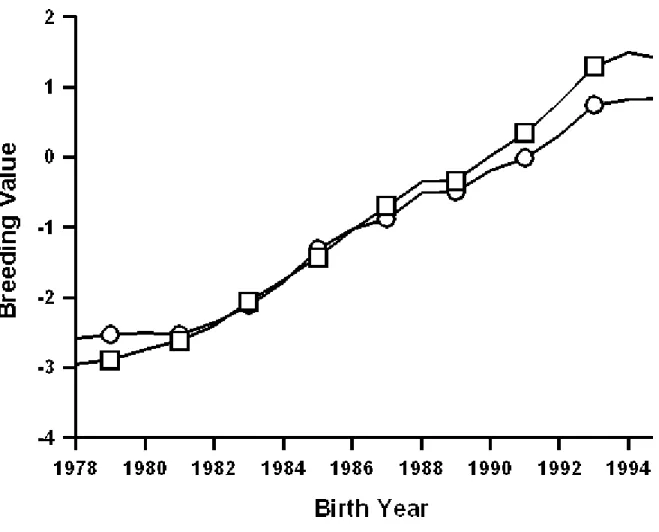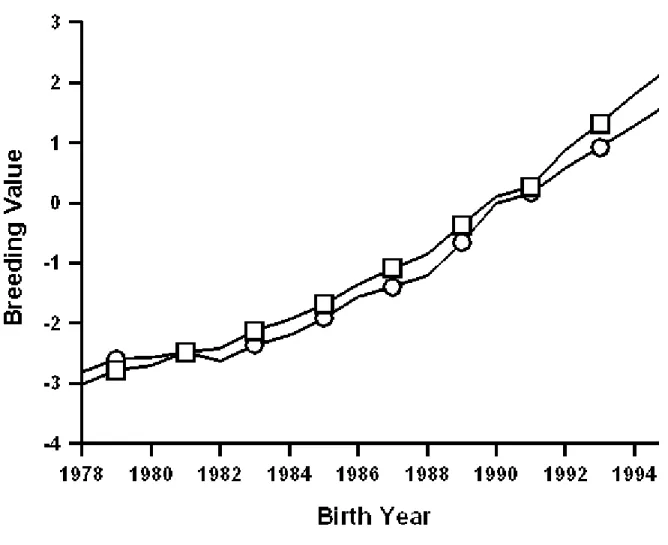Animal Model Genetic Evaluation of Type Traits for Five
Dairy Cattle Breeds
N. GENGLER,* G. R. WIGGANS, and J. R. WRIGHT *National Fund for Scientific Research, B-1000 Brussels, Belgium, and
Animal Science Unit, Gembloux Agricultural University, B-5030 Gembloux, Belgium Animal Improvement Programs Laboratory, Agricultural Research Service, USDA, Beltsville, MD 20705-2350
Received September 10, 1998. Accepted April 28, 1999. 1999 J. Dairy Sci 82(June)
ABSTRACT
A system to calculate genetic evaluations based on an animal model was developed for final score (single-trait model) and 15 linear type traits (multitrait model) of Ayrshires, Brown Swiss, Guernseys, Jerseys, and Milking Shorthorns. (Co)variance components were estimated from appraisals that were scored during 1988 and later and that included all linear traits. The model for (co)variance components included fixed effects for interactions of herd, appraisal date, and parity; parity and appraisal age; and parity and lactation stage. Random effects were included for permanent environment, animal, and residual. A canonical transformation was used with
approximate diagonalization. Data for estimating breeding values included appraisals from 1980. Effects for appraisal age and lactation stage were defined within appraisal year group. The model for calculation of breeding values also included a random effect of interaction between herd and sire. Solutions for appraisal age from a preliminary analysis were smoothed with a quadratic curve to generate additive age adjustments by month for appraisal age, parity, and appraisal year group. Correlations of solutions from this model and from the former USDA sire model for bulls that were born during 1975 or later and that had 20 daughters were highest (generally 0.90) for Guernseys and were lowest (generally <0.80) for Milking Shorthorns. The evaluation system was implemented in February 1998 and was extended to Red and Whites.
(Key words: linear type, final score, genetic evaluation, animal model)
INTRODUCTION
A single-trait repeatability sire model (12) was used to calculate genetic evaluations for type traits of Ayrshires, Brown Swiss, Guernseys, Jerseys, and Milking Shorthorns from 1978 until August 1997. For cows, a method developed by Norman et al. (13) was used to derive PTA indirectly.
animal models (6, 10). The computing requirements for analysis can be reduced greatly with canonical transformation (7), which transforms the initial, correlated traits to uncorrelated, canonical traits. Gengler et al. (6) applied this method to calculate type evaluations for Jerseys. Their method also included multiple diagonalization, which is a generalization of canonical transformation to several random effects rather than only additive genetic effects (3, 8, 11); an expectation-maximization algorithm that permits the use of this approach even if observations for some traits are missing for some cows (2); and accounting for inbreeding in the construction of the additive genetic relationship matrix (14, 16). The objective of this study was to adapt the method of Gengler et al. (6) to evaluate US Ayrshire, Brown Swiss, Guernsey, Jersey, and Milking Shorthorn dairy cattle for genetic merit of type traits.
MATERIAL AND METHODS
Data
Data included final scores and scores for 15 linear type traits (stature, strength, dairy form, foot angle, rear legs-side view, body depth, rump angle, thurl width, fore udder attachment, rear udder height, rear udder width, udder depth, udder cleft, front teat placement, and teat length). Scoring for body depth and teat length began during the late 1980s; therefore, many type records prior to 1990 were missing observations for those traits. Type records were those provided by the
Ayrshire Breeders Association (Brattleboro, VT), American Guernsey Association
(Reynoldsburg, OH), American Jersey Cattle Association (Reynoldsburg, OH), Brown Swiss Cattle Breeder's Association (Beloit, WI), and American Milking Shorthorn Society (Beloit, WI) to USDA for calculation of genetic evaluations that were released during August 1997.
Records before initiation of linear scoring (1980 for Jerseys, Guernseys, and Ayrshires; 1981 for Milking Shorthorns; and 1982 for Brown Swiss) were excluded. For Guernseys and Jerseys, only first and second lactation records were included. Appraisals had to be recorded before 61 mo of age for Ayrshires and before 69 mo of age for Brown Swiss and Milking Shorthorns. Numbers of records available are in Table 1 by trait and breed.
Pedigree data were extracted from the Animal Improvement Programs Laboratory database, and ancestors were traced back to 1970. Animals born before 1970 were considered to be the base populations for each breed.
Estimation of (Co)variance Components
Development of evaluation procedures required prior estimation of (co)variance components for each breed and trait. Only records that had observations for all 15 linear traits and final score were included in those estimations. To avoid extremely small contemporary groups, a minimum number of cows for each appraisal date of a herd was imposed: 5 cows for Ayrshires and
Milking Shorthorns, 15 cows for Brown Swiss and Guernseys, and 25 cows for Jerseys. To limit Jersey data to a manageable size for computing, only herd codes with a last digit of 0 or 9 and the preceding digit smaller than 5 were retained. Animals born before 1980 were considered to be the base population for (co)variance estimation. Table 2 shows numbers of appraisals, cows, and animals included in the relationship matrix by breed after elimination of animals that did not have a type score and were not related to at least two animals with type scores.
(Co)variance components were computed following the procedure developed by Misztal et al. (11) for Holstein type traits and applied by Gengler et al. (5). The two analyses done were 1) a single-trait analysis involving only final score and 2) a multitrait analysis for the 15 linear type traits using canonical transformation, multiple diagonalization with the F-G algorithm (3), and the expectation-maximization REML algorithm (9, 10, 11). Both analyses used the same general model:
y = Xh + Hc + Fd + Zp + Z*u + e
where y = vector of type records; h = vector of fixed effects of herd, date scored, and parity (first or later) group; c = vector of fixed effects of age at appraisal group within parity (first, second, or later); d = vector of fixed effects of lactation stage within parity (first, second, or later); p = vector of random effects of permanent environment; u = vector of random additive genetic effects of animals and genetic groups (u = a + Qg, where a = vector of random additive genetic effects of animals expressed as deviations from group means, g = vector of fixed effects of genetic groups, and Q = incidence matrix that links g with u); X, H, F, Z, and Z* = incidence matrices that associate h, c, d, p, and u, respectively, with y; and e = vector of random residual effects.
Age groups were defined for first parity as <25 mo, 25 mo and 26 mo, 27 mo and 28 mo, ...., 37 mo and 38 mo; for second parity as <41 mo, 41 mo and 42 mo, 43 mo and 44 mo, ..., 53 mo and 54 mo; and for later parities as <51 mo, 51 mo and 52 mo, 53 mo and 54 mo, 55 mo and 56 mo, 57 mo through 60 mo, 61 mo through 64 mo, and >64 mo. Age groups included more months for ages that occurred less frequently. Some parity or age classes did not exist for particular breeds, depending on the parity and age range of data allowed by the breed association for use in genetic evaluation.
To account for differences in mean genetic merit of unknown ancestors, by birth year, common genetic groups for sires and dams were included as proposed by Westell et al. (15). Eight genetic groups were defined based on birth year (<1981, 1981 and 1982, ..., 1991 and 1992, >1992).
Genetic Evaluation
A multitrait animal model similar to the model for estimation of (co)variance components but adapted for missing data (6) was applied:
y = Xh + Hc + Fd+ Ss + Zp + Z*u + e
where y, h, p, u, X, H, F, Z, Z*, and e are defined as for estimation of (co)variance components; c = vector of fixed effects of age group within parity (first, second, or later) and appraisal year group (before 1988 or 1988 and later); d = vector of fixed effects of lactation stage within parity (first, second, or later) and appraisal year group (before 1988 or 1988 and later); s = vector of random effects of interaction of herd and sire; and S = incidence matrix that associates s with y. Herd-sire interaction was considered in the genetic evaluation to avoid possible bias due to preferential treatment of the daughters of a sires in a particular herd. Age groups were defined similarly as for estimation of (co)variance components. Thirteen genetic groups were defined based on birth year (<1971, 1971 and 1972, ..., 1991 and 1992, >1992).
To account for the effect of age by single month of age, adjustment factors were derived to adjust data prior to analysis. Solutions of fixed effects were calculated using the model for genetic evaluations. Then, the solutions for c were regressed on the mean age and its square for the corresponding age group by breed and appraisal year group (before 1988 or 1988 and later). Data then were adjusted prior to analysis by subtracting the value of the curve evaluated at that age. Solutions and reliabilities were computed using the method of Gengler et al. (6) and the (co) variances estimated in this study. The procedures for evaluation were based on a canonical transformation extended to multiple random effects, which allowed for missing values (2, 4, 6). During variance component estimation, (co)variances were not estimated for the interaction of herd and sire. The values used in genetic evaluation were obtained by subdividing the initial permanent environmental (co)variances into 40% herd-sire and 60% permanent environmental (co)variances. The herd-sire (co)variances were approximated to avoid confounding between permanent environment and herd-sire interaction and to enforce a limit on the effect a single herd can have on the evaluation of a bull. This approach generated a herd-sire variance that was somewhat less than the 10% of total variance used with the former USDA sire model (12) and the 9% of total variance used by Holstein Association USA (Brattleboro, VT) with its current animal model for type traits (11). Inbreeding was included in the construction of the inverse of the relationship matrix with the method for US yield evaluations (16). If known, prior solutions were used to speed convergence. The single-trait and multitrait analyses for final score and linear traits, respectively, were calculated simultaneously for each breed by setting all (co)variances between final score and linear type traits to zero. Solutions for additive genetic effects were expressed as PTA (half the estimates of u), and the mean PTA for cows born during 1990 was set to zero. Reliabilities were calculated using the method of Gengler and Misztal (4).
RESULTS AND DISCUSSION
(Co)variance Components
Comparisons between heritabilities used in the former sire model and those estimated with an animal model are in Table 3. Animal model estimates for heritability of final score tended to be the same or lower than sire model estimates for all breeds. For Ayrshires, Guernseys, and
Jerseys, the mean changes were positive, and the animal model estimates of heritability tended to be higher for linear traits, especially udder traits; for Brown Swiss and Milking Shorthorns, animal model estimates tended to be lower. Some traits, such as final score, had only minor differences between breeds, but other traits, such as udder cleft, had substantial differences among breeds. Those results support the use of different heritabilities by breed. Compared with the results of Gengler et al. (5), the results for Jerseys were 0.02 lower on average. Some of this difference might have resulted from sampling variation, as the data set for this study was different than the one used by Gengler et al. (5), particularly in the way that data were selected and adjusted prior to analysis. Also, the model for this study was slightly different. Final score differences can be attributed to different trait definition. In this study, Jersey final score was calculated from individual linear traits; in the study by Gengler et al. (5) final score was assigned by the appraiser.
Genetic and phenotypic correlations between linear traits are shown in Table 4 for Brown Swiss, Table 5 for Guernseys, and Table 6 for Jerseys, the three breeds in this study with the largest populations. In general, correlations were similar across breeds, although there were some
exceptions. Genetic correlations of fore udder attachment with other traits varied most among breeds (differences up to 0.67). Dairy form also had large variations among breeds for genetic correlations with thurl width, fore udder attachment, rear udder width, and udder depth as did correlations of udder depth with stature, rear udder height, and rear udder width. Genetic correlations of rear legs with stature, strength, body depth, and thurl width were negative for Jerseys (-0.10 to -0.25) but close to 0 for Guernseys and Brown Swiss. Fore udder attachment was much less correlated genetically with rear udder width and rear udder height for Guernseys than for Brown Swiss or Jerseys. Genetic correlation between front teat placement and teat length varied from highly negative 0.40) for Brown Swiss to slightly negative for Guernseys (-0.15) and Jerseys (-0.09). Phenotypic correlations tended to be more similar. The only recent comparable results in the US were those calculated by Gengler et al. (5) for Jerseys. For genetic correlations, mean absolute differences were rather small (0.044) for Jerseys, as expected, but were present. Similar to heritability, those differences were probably the result of differences in data and models. The mean absolute differences from the Jersey correlations of Gengler et al. (5) were, on average, over two times larger for Brown Swiss and Guernseys (0.103 and 0.102, respectively). For phenotypic correlations, those differences were smaller.
Age Adjustment Prior to Analysis
Examples of regression coefficients for age adjustment of data prior to analysis are shown in Table 7 for stature. Because parity was included in several fixed effects, intercept values were arbitrary and are not shown. Linear and quadratic regression coefficients were substantially different among breeds and parities. For first parity, differences between age adjustments for stature scores at 20 and 28 mo were 5.6 for Ayrshires, 3.6 for Brown Swiss, 6.7 for Guernseys, 6.0 for Jerseys, and 5.2 for Milking Shorthorns; for second parity, differences between age adjustments for stature scores at 34 and 40 mo were 0.8 for Ayrshires, 2.2 for Brown Swiss, 1.1 for Guernseys, 1.3 for Jerseys, and 4.8 for Milking Shorthorns. Additional groups for appraisal year may be warranted in the future.
Genetic Evaluations
Computations were performed on a workstation (IBM RISC System 6000, Model J30; IBM Corporation, Armonk, NY) with 2048 MB of memory. Fewer than 50 iterations were required for squared relative differences of solutions to be <0.1e-7.
Correlations of multitrait animal model PTA for linear traits and single-trait animal model PTA for final score with former sire model PTA are in Table 8 for sires born during 1975 or later and that had 20 daughters. The mean correlation was highest for Guernseys, and most Guernsey correlations were 0.90; the lowest mean correlation was 0.75 for Milking Shorthorns, and few Milking Shorthorn correlations were 0.80. Correlations for Jerseys were similar to those reported by Gengler et al. (6) using a similar model.
Differences between solutions from animal and sire models could have been the result of differences in data, data adjustments, models, and genetic parameters. Another important difference was that information from all relatives affected evaluations from the animal model; sons and dams contributed to bulls, and progeny contributed to cows. Also, because animal model PTA for linear type traits resulted from a multitrait analysis, information from one trait
affected PTA of all correlated traits. Unlike the sire model, the animal model included unknown-parent groups, which were assigned by birth year and enabled more accurate estimation of genetic trend.
Genetic Trend
Genetic trends were computed from EBV for cows born between 1979 and 1995. The EBV, not PTA, was used to reflect the full genetic effect. Cows with birth years before 1979 were not considered because few of those cows had an appraisal record included in the data.
Figures 1 to 9 are plots of the genetic trends for the former sire model and the animal model, expressed on the same base (cows born in 1990, reported are the matching subsets of cows having both evaluations), for final score, rump angle, and udder depth of Brown Swiss,
Guernseys, and Jerseys. Genetic trends for final score (Figures 1 to 3) were similar and positive for both models and all three breeds, although Brown Swiss showed a somewhat slower increase than did Guernseys and Jerseys. Genetic trends for rump angle (Figures 4 to 6) also were similar for both models and all three breeds, but no clear trend pattern was evident. For udder depth (Figures 7 to 9), differences between animal and sire models were evident for all three breeds. For Brown Swiss (Figure 7), trend from the sire model was substantially positive but only slightly positive from the animal model. For Guernseys (Figure 8) and Jerseys (Figure 9), trend direction reversed: positive for the sire model and negative for the animal model. Trends for all three traits of Jerseys were similar to those reported by Gengler et al. (6).
Differences among genetic trends may have been caused by the new methods of accounting for effects of age at appraisal and stage of lactation, by the use of a single-trait (final score) or multitrait animal model instead of a sire model, or by the new (co)variance components. The influence of inadequate age adjustments has been identified for yield traits (1) as a major source of bias in genetic trends. Udder depth was the type trait for which genetic trends from the former sire model appeared to be most in error.
CONCLUSIONS
A new system was developed for the genetic evaluation of final score and linear traits for five breeds of dairy cattle. The same animal model was used for all traits, but a single-trait animal model was applied for final score, and a multitrait animal model was used for all linear type traits within breed. New (co)variance components were estimated. The evaluation procedures were based on a canonical transformation extended to multiple random effects, which allowed for missing values, and accounted for inbreeding in the inverse of the relationship matrix.
Comparison of this animal model and the former USDA sire model evaluations showed large differences that were specific to breeds and traits.
Genetic trends from the animal model were, in general, different from those from the former sire model. The new genetic trend for final score was positive to highly positive. For rump angle and udder depth, genetic trends tended to be different among breeds.
The system developed in this study for calculating PTA for type traits was implemented in the US in February 1998 for the genetic evaluation of type traits of Ayrshires, Brown Swiss,
Guernseys, Jerseys, and Milking Shorthorns. The system also was extended to Red and Whites in February 1998. Heritability for final score for Red and Whites was estimated to be 0.26 based on 3534 appraisal records of 2523 cows that were 78 mo of age and 6529 animals included in the relationship matrix; repeatability was estimated to be 0.63. For linear type traits of Red and Whites, (co)variance components were those estimated for Holsteins by Mistzal et al. (11).
ACKNOWLEDGMENTS
The financial support of National Fund for Scientific Research, Brussels, Belgium, is acknowledged. N. Gengler is Research Team Leader for the National Fund for Scientific
Research. The financial support of the American Jersey Cattle Association (Reynoldsburg, OH), American Guernsey Association (Reynoldsburg, OH), and Ayrshire Breeders Association (Brattleboro, VT) also is acknowledged by the authors. The authors thank C. W. Wolfe,
American Jersey Cattle Association, and J. C. Philpot, L. A. Smith, and S. M. Hubbard, Animal Improvement Programs Laboratory, ARS, USDA, for manuscript review. The authors also thank I. Misztal for providing the computer program to estimate variance components; this program is available at ftp://nce.ads.uga.edu. Development of the public domain version of the genetic evaluation program was supported by the European Union Concerted Action "Genetic Improvement of Functional Traits in Cattle", and the program is available at
http://www.boku.ac.at/nuwi/gift/mtjaam.htm.
REFERENCES
1 Bonaïti, B., D. Boichard, A. Barbat, and S. Mattalia. 1993. Problems arising with genetic trend estimation in dairy cattle. Proc. Open Session Interbull Annu. Mtg., Aarhus,
Denmark, August 19-20, 1993. Int. Bull Eval. Serv. Bull No. 8, Dep. Anim. Breed. Genet., SLU, Uppsala, Sweden.
2 Ducrocq, V., and B. Besbes. 1993. Solution of multiple trait animal models with missing data on some traits. J. Anim. Breed. Genet. 110:81-92.
3 Flury, B. N., and G. Constantine. 1985. Algorithm AS211: the F-G diagonalization algorithm. Appl. Stat. 34:177-185.
4 Gengler, N., and I. Misztal. 1996. Approximation of reliability for multiple-trait animal models with missing data by canonical transformation. J. Dairy Sci. 79:317-328. 5 Gengler, N., G. R. Wiggans, J. R. Wright, H. D. Norman, and C. W. Wolfe. 1997.
Estimation of (co)variance components for Jersey type traits using a repeatability model. J. Dairy Sci. 80:1801-1806.
6 Gengler, N., G. R. Wiggans, J. R. Wright, H. D. Norman, and C. W. Wolfe. 1997.
Application of canonical transformation with missing values to multitrait evaluation of Jersey type. J. Dairy Sci. 80:2563-2571.
7 Jensen, J., and I. L. Mao. 1988. Transformation algorithms in analysis of single trait and of multitrait models with equal design matrices and one random factor by trait: a review. J. Anim. Sci. 66:2750-2761.
8 Lin, C. Y., and S. P. Smith. 1990. Transformation of multitrait to unitrait mixed model analysis of data with multiple random effects. J. Dairy Sci. 73:2494-2502.
9
Misztal, I. 1990. Restricted maximum likelihood estimation of variance components in animal model using sparse matrix inversion and a supercomputer. J. Dairy Sci.
172.
10 Misztal, I., T. J. Lawlor, and T. H. Short. 1993. Implementation of single- and multiple-trait animal models for genetic evaluation of Holstein type multiple-traits. J. Dairy Sci. 76:1421-1432.
11 Misztal, I., K. Weigel, and T. J. Lawlor. 1995. Approximation of estimates of (co)variance components with multiple trait restricted maximum likelihood by multiple diagonalization for more than one random effect. J. Dairy. Sci. 78:1862-1872.
12 Norman, H. D., B. G. Cassell, G. J. King, R. L. Powell, and E. E. Wright. 1979. Sire evaluation for conformation of Jersey cows. J. Dairy Sci. 62:1914-1921.
13 Norman, H. D., B. G. Cassell, R. L. Powell, and E. P. Barton. 1980. Cow indexes for type and production-type indexes for Jersey cows. J. Dairy Sci. 63(Suppl. 1):108.(Abstr.)
14 VanRaden, P. M. 1992. Accounting for inbreeding and crossbreeding in genetic evaluation of large populations. J. Dairy Sci. 75:3136-3144.
15 Westell, R. A., R. L. Quaas, and L. D. Van Vleck. 1988. Genetic groups in an animal model. J. Dairy Sci. 71:1310-1318.
16 Wiggans, G. R., P. M. VanRaden, and J. Zuurbier. 1995. Calculation and use of inbreeding coefficients for genetic evaluation of United States dairy cattle. J. Dairy Sci. 78:1584-1590.
TABLE 1. Numbers of records by breed and type trait.
Trait Ayrshire
Brown
Swiss Guernsey Jersey
Milking Shorthorn (no.) Final score 28,181 119,781 122,153 479,299 16,991 Stature 28,189 119,781 122,153 479,299 16,886 Strength 28,189 119,781 122,153 479,299 16,886 Dairy form 28,189 119,781 122,153 479,299 16,886 Foot angle 28,189 94,164 122,153 479,299 16,886
Rear legs (side view) 28,189 119,781 122,153 479,299 16,886
Body depth 9692 62,959 56,409 283,448 7356
Rump angle 28,081 119,781 122,153 479,298 16,886
Thurl width 28,189 119,781 122,153 479,297 16,886
Fore udder attachment 28,189 119,781 122,153 479,299 16,886
Rear udder height 28,189 119,781 122,152 479,297 16,886
Rear udder width 28,189 119,781 122,153 479,298 16,886
Udder depth 28,189 119,781 122,153 479,296 16,886
Udder cleft 28,189 119,781 122,152 479,297 16,885
Teat length 9692 62,959 69,507 324,370 7356
TABLE 2. Numbers of appraisal records, cows, and animals included in the relationship matrix used in estimation of variance components by breed.
Category Ayrshire
Brown
Swiss Guernsey Jersey
Milking Shorthorn (no.)
Appraisal records 6947 27,832 38,878 32,468 3425
Cows 4700 14,382 24,253 19,741 2182
Animals in relationship matrix 11,418 30,448 47,051 40,721 5062
TABLE 3. Heritability estimates for type traits.
Trait Sire model1 Animal model Ayrshire Brown
Swiss Guernsey Jersey
Milking Shorthorn Final score 0.23 to 0.37 0.26 0.27 0.26 0.23 0.28 Stature 0.40 0.45 0.39 0.48 0.39 0.41 Strength 0.24 0.31 0.21 0.30 0.25 0.26 Dairy form 0.16 0.24 0.18 0.34 0.23 0.18 Foot angle 0.12 0.11 0.08 0.11 0.10 0.09
Rear legs (side view) 0.12 0.10 0.14 0.18 0.10 0.09
Body depth 0.34 0.38 0.23 0.33 0.25 0.30
Rump angle 0.27 0.30 0.24 0.40 0.31 0.19
Thurl width 0.24 0.29 0.13 0.30 0.20 0.16
Fore udder attachment 0.18 0.26 0.16 0.23 0.22 0.11
Rear udder height 0.17 0.29 0.19 0.32 0.26 0.13
Rear udder width 0.17 0.23 0.15 0.32 0.23 0.12
Udder depth 0.27 0.25 0.24 0.38 0.38 0.27
Udder cleft 0.16 0.25 0.13 0.18 0.20 0.05
Teat length 0.26 0.29 0.26 0.30 0.26 0.24
Mean change in heritability . . . 0.04 -0.03 0.07 0.02 -0.04
1 Sire model heritabilities were the same for linear traits across breed; heritabilities for final
score differed by breed: 0.30 for Ayrshires, 0.37 for Brown Swiss, 0.30 for Guernseys, 0.23 for Jerseys, and 0.30 for Milking Shorthorns.
TABLE 4. Genetic (above diagonal) and phenotypic (below diagonal) correlations among 15 line of Brown Swiss.
Trait Stature Strength Dairy form Foot angle Rear legs Body depth Rump angle Thurl width Fore udder attach-ment Rear udder height Rear udder width Udder depth Udd cle Stature . . . 0.74 0.56 0.39 0.06 0.60 0.11 0.70 0.18 0.27 0.32 0.15 0.1 Strength 0.54 . . . 0.26 0.36 0.02 0.88 0.07 0.93 0.21 0.15 0.42 -0.15 0.1 Dairy form 0.23 -0.04 . . . 0.12 0.13 0.48 -0.11 0.25 0.23 0.53 0.58 -0.13 0.2 Foot angle 0.14 0.15 0.03 . . . -0.43 0.22 -0.08 0.33 0.26 0.26 0.29 0.19 0.0 Rear legs (side view) -0.01 -0.06 0.09 -0.19 . . . 0.08 0.05 -0.02 -0.09 -0.10 -0.03 -0.14 0.0 Body depth 0.43 0.69 0.18 0.11 -0.01 . . . 0.01 0.79 0.17 0.20 0.47 -0.32 0.1 Rump angle 0.08 0.03 -0.01 -0.03 0.03 0.01 . . . -0.12 -0.25 -0.28 -0.22 -0.14 -0.1 Thurl width 0.38 0.54 -0.01 0.14 -0.03 0.46 -0.01 . . . 0.28 0.25 0.47 -0.10 0.1 Fore udder attachment 0.11 0.17 0.12 0.12 -0.06 0.15 -0.08 0.14 . . . 0.64 0.61 0.51 0.2 Rear udder height 0.14 0.09 0.29 0.12 -0.06 0.11 -0.09 0.12 0.44 . . . 0.82 0.24 0.2 Rear udder width 0.14 0.18 0.33 0.12 -0.07 0.21 -0.04 0.19 0.38 0.61 . . . -0.06 0.3 Udder depth 0.09 -0.02 -0.10 0.05 -0.04 -0.12 -0.08 0.00 0.25 0.10 -0.08 . . . 0.1 Udder cleft 0.04 0.04 0.14 0.04 0.00 0.07 -0.03 0.05 0.16 0.19 0.23 0.13 .
Front teat placement 0.03 0.06 0.06 0.03 0.01 0.06 -0.06 0.05 0.24 0.13 0.13 0.22 0.1 Teat length 0.11 0.10 0.08 0.03 -0.01 0.11 0.02 0.08 -0.04 0.04 0.07 -0.14 0.0
TABLE 5. Genetic (above diagonal) and phenotypic (below diagonal) correlations among 15 line of Guernseys.
Trait Stature Strength Dairy form Foot angle Rear legs Body depth Rump angle Thurl width Fore udder attach-ment Rear udder height Rear udder width Udder depth Udd cle Stature . . . 0.79 0.65 0.37 0.05 0.70 0.23 0.78 -0.12 0.41 0.50 -0.17 0.2 Strength 0.59 . . . 0.61 0.42 0.00 0.88 0.09 0.93 -0.09 0.35 0.57 -0.34 0.2 Dairy form 0.44 0.37 . . . 0.30 0.04 0.70 0.05 0.65 -0.32 0.71 0.87 -0.52 0.4 Foot angle 0.17 0.22 0.15 . . . -0.30 0.30 -0.13 0.44 0.19 0.33 0.35 0.04 0.1 Rear legs (side view) 0.00 -0.07 0.01 -0.17 . . . 0.04 -0.01 0.03 -0.10 -0.14 -0.08 -0.08 -0.0 Body depth 0.52 0.71 0.49 0.17 -0.03 . . . 0.11 0.81 0.17 0.36 0.58 -0.47 0.2 Rump angle 0.15 0.04 0.04 -0.05 0.01 0.06 . . . 0.03 -0.27 -0.07 -0.03 -0.17 -0.0 Thurl width 0.54 0.68 0.40 0.21 -0.04 0.57 0.01 . . . -0.07 0.45 0.65 -0.31 0.3 Fore udder attachment -0.05 0.02 -0.11 0.11 -0.07 -0.03 -0.17 0.01 . . . 0.22 -0.06 0.80 -0.0 Rear udder height 0.29 0.24 0.52 0.17 -0.08 0.27 -0.04 0.30 0.20 . . . 0.86 -0.01 0.4 Rear udder width 0.34 0.38 0.64 0.20 -0.08 0.40 -0.01 0.43 0.06 0.71 . . . -0.35 0.5 Udder depth -0.10 -0.17 -0.29 0.04 -0.05 -0.26 -0.14 -0.16 0.50 0.06 -0.15 . . . -0.0 Udder cleft 0.10 0.13 0.25 0.09 -0.03 0.15 -0.02 0.15 0.10 0.30 0.32 0.09 .
Front teat placement 0.03 0.08 0.12 0.08 -0.01 0.10 -0.05 0.08 0.25 0.19 0.19 0.20 0.2 Teat length 0.22 0.22 0.19 0.07 -0.01 0.21 0.02 0.22 -0.03 0.13 0.18 -0.14 0.1
TABLE 6. Genetic (above diagonal) and phenotypic (below diagonal) correlations among 15 line of Jerseys.
Trait Stature Strength Dairy form Foot angle Rear legs Body depth Rump angle Thurl width Fore udder attach-ment Rear udder height Rear udder width Udder depth Udd cle Stature . . . 0.77 0.40 0.37 -0.10 0.65 0.21 0.74 0.15 0.24 0.37 0.03 0.1 Strength 0.55 . . . 0.33 0.40 -0.25 0.90 0.18 0.96 0.10 0.14 0.43 -0.21 0.1 Dairy form 0.26 0.21 . . . 0.16 0.10 0.50 0.12 0.38 -0.03 0.58 0.77 -0.32 0.3 Foot angle 0.16 0.20 0.11 . . . -0.54 0.29 -0.02 0.42 0.35 0.28 0.28 0.23 0.1 Rear legs (side view) -0.04 -0.12 0.06 -0.26 . . . -0.11 0.07 -0.23 -0.23 -0.11 -0.09 -0.17 -0.0 Body depth 0.46 0.72 0.35 0.15 -0.03 . . . 0.18 0.85 -0.01 0.18 0.48 -0.37 0.2 Rump angle 0.15 0.10 0.11 0.01 0.05 0.12 . . . 0.09 -0.24 -0.08 -0.01 -0.21 0.0 Thurl width 0.46 0.69 0.26 0.22 -0.09 0.58 0.08 . . . 0.18 0.23 0.50 -0.15 0.2 Fore udder attachment 0.08 0.14 0.05 0.17 -0.06 0.08 -0.09 0.17 . . . 0.59 0.40 0.77 0.2 Rear udder height 0.16 0.15 0.51 0.15 -0.02 0.20 0.01 0.21 0.40 . . . 0.85 0.35 0.4 Rear udder width 0.23 0.32 0.59 0.16 -0.03 0.35 0.04 0.37 0.30 0.73 . . . 0.01 0.4 Udder depth 0.02 -0.11 -0.17 0.10 -0.06 -0.20 -0.11 -0.07 0.47 0.22 0.03 . . . 0.1 Udder 0.07 0.11 0.27 0.11 0.02 0.14 0.02 0.13 0.21 0.37 0.37 0.17 .
cleft Front teat placement 0.07 0.12 0.20 0.11 0.02 0.14 0.00 0.14 0.32 0.30 0.31 0.23 0.4 Teat length 0.19 0.19 0.12 0.07 -0.03 0.18 0.04 0.17 0.03 0.10 0.14 -0.06 0.1
TABLE 7. Linear and quadratic regression coefficients for appraisal age group1 by breed and
parity for stature scores during 1988 and later.
Breed
First parity Second parity
Linear Quadratic Linear Quadratic
Ayrshire 1.31 -0.0128 0.11 0.0003
Brown Swiss 0.43 0.0005 1.34 -0.0131
Guernsey 1.76 -0.0192 0.22 -0.0004
Jersey 1.49 -0.0153 0.37 -0.0020
Milking Shorthorn 1.32 -0.0140 4.01 -0.0433
1Age at appraisal measured in months.
TABLE 8. Correlations between PTA that were calculated in August 1997 with a sire model and PTA that were calculated in February 1998 with a single-trait (final score) or a multitrait (linear type traits) animal model for bulls that were born during 1975 or later and had 20 daughters.
Trait Ayrshire
Brown
Swiss Guernsey Jersey
Milking Shorthorn Final score 0.83 0.87 0.91 0.91 0.83 Stature 0.90 0.86 0.95 0.91 0.89 Strength 0.81 0.74 0.92 0.86 0.78 Dairy form 0.66 0.77 0.92 0.92 0.71 Foot angle 0.76 0.72 0.84 0.80 0.68
Rear legs (side view) 0.76 0.83 0.87 0.81 0.76
Body depth . . . 0.82 0.79 . . .
Thurl width 0.83 0.68 0.93 0.86 0.71
Fore udder attachment 0.84 0.82 0.79 0.85 0.64
Rear udder height 0.84 0.85 0.90 0.89 0.81
Rear udder width 0.79 0.74 0.90 0.89 0.68
Udder depth 0.70 0.62 0.83 0.77 0.81
Udder cleft 0.83 0.84 0.87 0.87 0.67
Teat placement 0.85 0.89 0.91 0.89 0.79
Teat length . . . 0.90 0.85 . . .
Mean 0.81 0.79 0.89 0.86 0.75
Figure 1. Comparison of genetic trends estimated from the former sire model ( ) and the current model ( ) for final score of Brown Swiss cows that were born during 1979 through 1995.
Figure 2. Comparison of genetic trends estimated from the former sire model ( ) and the current model ( ) for final score of Guernsey cows that were born during 1979 through 1995.
Figure 3. Comparison of genetic trends estimated from the former sire model ( ) and the current model ( ) for final score of Jersey cows that were born during 1979 through 1995.
Figure 4. Comparison of genetic trends estimated from the former sire model ( ) and the current model ( ) for rump angle of Brown Swiss cows that were born during 1979 through 1995.
Figure 5. Comparison of genetic trends estimated from the former sire model ( ) and the current model ( ) for rump angle of Guernsey cows that were born during 1979 through 1995.
Figure 6. Comparison of genetic trends estimated from the former sire model ( ) and the current model ( ) for rump angle of Jersey cows that were born during 1979 through 1995.
Figure 7. Comparison of genetic trends estimated from the former sire model ( ) and the current model ( ) for udder depth of Brown Swiss cows that were born during 1979 through 1995.
Figure 8. Comparison of genetic trends estimated from the former sire model ( ) and the current model ( ) for udder depth of Guernsey cows that were born during 1979 through 1995.
Figure 9. Comparison of genetic trends estimated from the former sire model ( ) and the current model ( ) for udder depth of Jersey cows that were born during 1979 through 1995.
